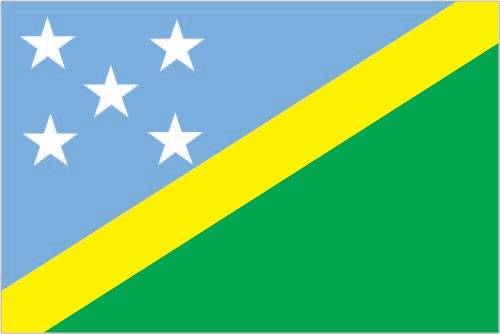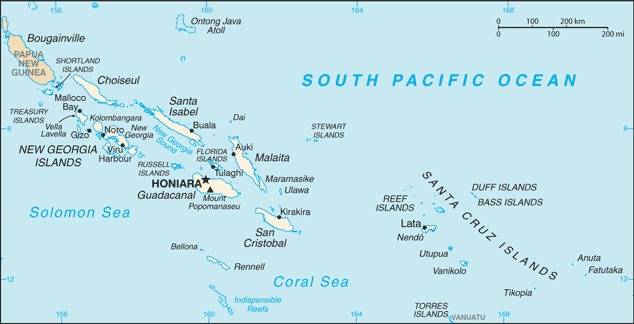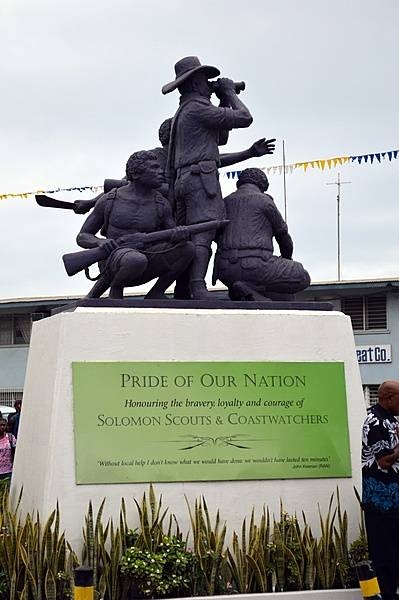50 Solomon Islands

Divided diagonally by a thin yellow stripe from the lower hoist-side corner. The upper triangle (hoist side) is blue with five white five-pointed stars arranged in an X pattern. The lower triangle is green. Blue represents the ocean, green the land, and yellow sunshine. The five stars stand for the five main island groups of the Solomon Islands.
Flag courtesy of the CIA World Factbook

Map courtesy of the CIA World Factbook

The Solomon Scouts and Coastwatchers Memorial at Honiara, Guadalcanal. The Solomon Scouts and Coastwatchers provided invaluable support and aid to the Allied effort during World War II.
Photo courtesy of the CIA World Factbook
Government
According to Britannica, Solomon Islands is a constitutional monarchy, with the British monarch, represented by a governor-general, serving as the formal head of state. Still, the country, a member of the Commonwealth, is independent, and the governor-general is appointed on the advice of the unicameral National Parliament. The governor-general, who serves a term of up to five years, must be a citizen of Solomon Islands. Members of the Parliament are elected by universal adult suffrage and serve for four years (unless Parliament is dissolved sooner). Executive power is exercised by a prime minister (elected by and from Parliament) and a cabinet appointed by the governor-general from among the members of Parliament on the recommendation of the prime minister. Although political parties exist in name, their organization and discipline tend to be loose. The prime minister rarely commands a clear majority in Parliament, and so governments are usually formed of a coalition of parties or factions. Local government councils control matters regarding transportation, economic development, health, and education.
Civil Aviation Authority of Solomon Islands (CAASI)
Pacific Aviation Safety Office (PASO)
The Pacific Aviation Safety Office (PASO) is an international organization providing quality aviation safety and security service for Member States in the Pacific.
PASO is the sole international organization responsible for regional regulatory aviation safety oversight service for the 10 Pacific States who are signatories to the Pacific Islands Civil Aviation Safety and Security Treaty (PICASST).
The current PICASST signatories are the Pacific nations of Cook Islands, Kiribati, Nauru, Niue, Papua New Guinea, Samoa, Solomon Islands, Tonga, Tuvalu, and Vanuatu. Associate Members of PASO are Australia, Fiji and New Zealand. Government representatives from these nations make up the PASO Council.
Airspace
SkyVector – Google Maps – ADS-B Exchange
ICAO countries publish an Aeronautical Information Publication (AIP). This document is divided into three parts: General (GEN), En Route (ENR) and Aerodromes (AD). ENR 1.4 details the types of airspace classes they chose to adopt from classes A through G.
Drone Regulations
AIS – Drone Page – The Civil Aviation Authority (PEL Office) is responsible for the Operational requirements regarding registration of UAV (drones) in Solomon Islands. CAASI office ensures UAV (drones) operational requirements are com pliance with Civil Aviation Rules (CAR)
Part_101_Gliders & Parasails, Unmanned Operating Rules 2017 – Gyrogliders and Parasails, Unmanned Aircraft (including Balloons), Kites and Rockets – Operating Rules and;
Part_102_Unmanned Air Operator Certification
Outlines requirements regarding UAV (drones) heavier than 25kg and requires applicants to submit an “exposition” or manual showing that they have identified hazards and risks of their operations, and ways they will mitigate those risks.
Part 101 CAA Consolidation 10 March 2017
Gyrogliders and Parasails, Unmanned Aircraft (including Balloons), Kites, and Rockets – Operating Rules.
Adopted by Solomon Islands Government under S32 & S42 of the CAA Act 2008
This document is the current consolidated version of Part 101 produced by the Civil Aviation Authority, and serves as a reference only. It is compiled from the official ordinary rules that have been signed into law by the Minister of Transport. Copies of the official rule and amendments as signed by the Minister of Transport may be obtained from the Civil Aviation Authority or may be downloaded from the official web site.
Part 102 CAA Consolidation 24 September 2015
Unmanned Aircraft Operator Certification
This document is the current consolidated version of Part 102 produced by the Civil Aviation Authority, and serves as a reference only. It is compiled from the official ordinary rules that have been signed into law by the Minister of Transport. Copies of the official rule and amendments as signed by the Minister of Transport may be obtained from the Civil Aviation Authority or may be downloaded from the official web site.
Advanced Air Mobility (AAM) Regulations & Policies
None found by the author.
However, should you, the reader, happen to stumble across something to the contrary, please email the author at FISHE5CA@erau.edu and you may be mentioned in the ACKNOWLEDGEMENTS section of this book by way of thanks for contributing to this free eBook!
Advanced Air Mobility (AAM) News
None found by the author.
However, should you, the reader, happen to stumble across something to the contrary, please email the author at FISHE5CA@erau.edu and you may be mentioned in the ACKNOWLEDGEMENTS section of this book by way of thanks for contributing to this free eBook!
Short Essay Questions
Scenario-Based Question
You have been hired by a Drone Startup Company. Your boss has immediately assigned this job to you.
They need you to prepare a one-page memo detailing the legalities of using a drone at the Solomon Scouts and Coastwatchers Memorial at Honiara, Guadalcanal, pictured above.
They need you to mention any national laws and local ordinances.
They specifically want to know what airspace (insert pictures) you will be operating in and whether or not you need an airspace authorization.
Does it matter whether or not you are a citizen of the country?
Lastly, there is a bonus for you if, as you scroll through this chapter, you find any typos or broken links!
Short Essay Questions
- What are the drone categories?
- How is registration addressed?
- How is remote ID addressed?
- What are the model aircraft rules?
- What are the commercial drone rules?
- Are there waivers or exemptions to the rules? If so, for what?
- Would you share a link to an interactive airspace map?
- How is BVLOS addressed?
- How can you fly drones at night?
- How can you fly drones over people?
- Where do you find drone NOTAMs?
- What are the rules for drone maintenance?
- What are the rules for an SMS program?
- What are some unique rules not mentioned above?
- What are the C-UAS rules?
- What are the AAM rules?

